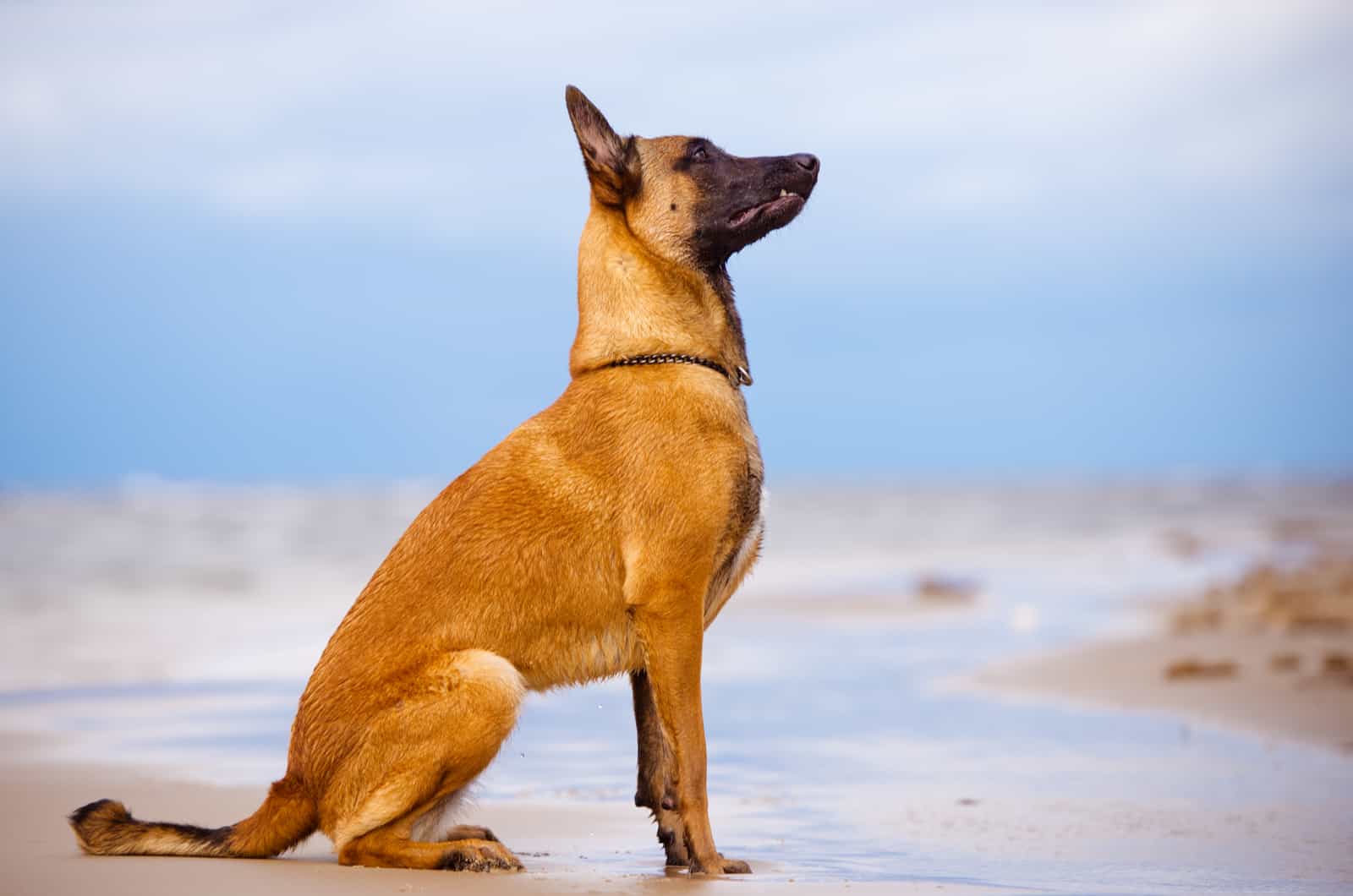When choosing the perfect dog breed for yourself, there are many things you might look at prior to making a decision. One of them is shedding; an important factor if you’re someone who prefers to have a clean home, without loose hairs flying everywhere.
So, what about the amount of Belgian Malinois shedding? Do these dogs shed a lot?
If you’re interested in becoming a Belgian Malinois owner, you are likely looking into as much information on this breed as possible. Asking questions about Belgian Malinois shedding is a good way to start.
Malinois belong to herding breeds with a strong prey drive, meaning they require lots of socialization and dog training. They make excellent guard dogs, although some people like to have them as loyal family companions.
They originate from Malines, a city in Belgium, which is how they’ve gotten their name. Just like Pitbulls or Rottweilers, they are considered a dangerous breed, but we’d like to disagree. With proper ownership, all dogs can make great family pets!
Belgian Malinois are a dog breed that is commonly mistaken for German Shepherds. While these two breeds look alike, there are many noticeable differences – and some of them are related to Belgian Malinois shedding.
Also, Belgian Malinois dogs are sometimes confused with Belgian Sheepdog. Still, these dogs don’t have too many things alike, other than their country of origin, and that both are herding dogs.
They are, however, related to other Belgian shepherd dogs, Laekenois, Tervurens, and Groenendaels.
All four of these Belgian dog breeds can do amazing on Schutzhund and IPO training, making them amazing working dogs. This is especially true when it comes to completing police work.
Here is everything that might interest you about Belgian Malinois shedding and grooming requirements:
Do Belgian Malinois Shed?
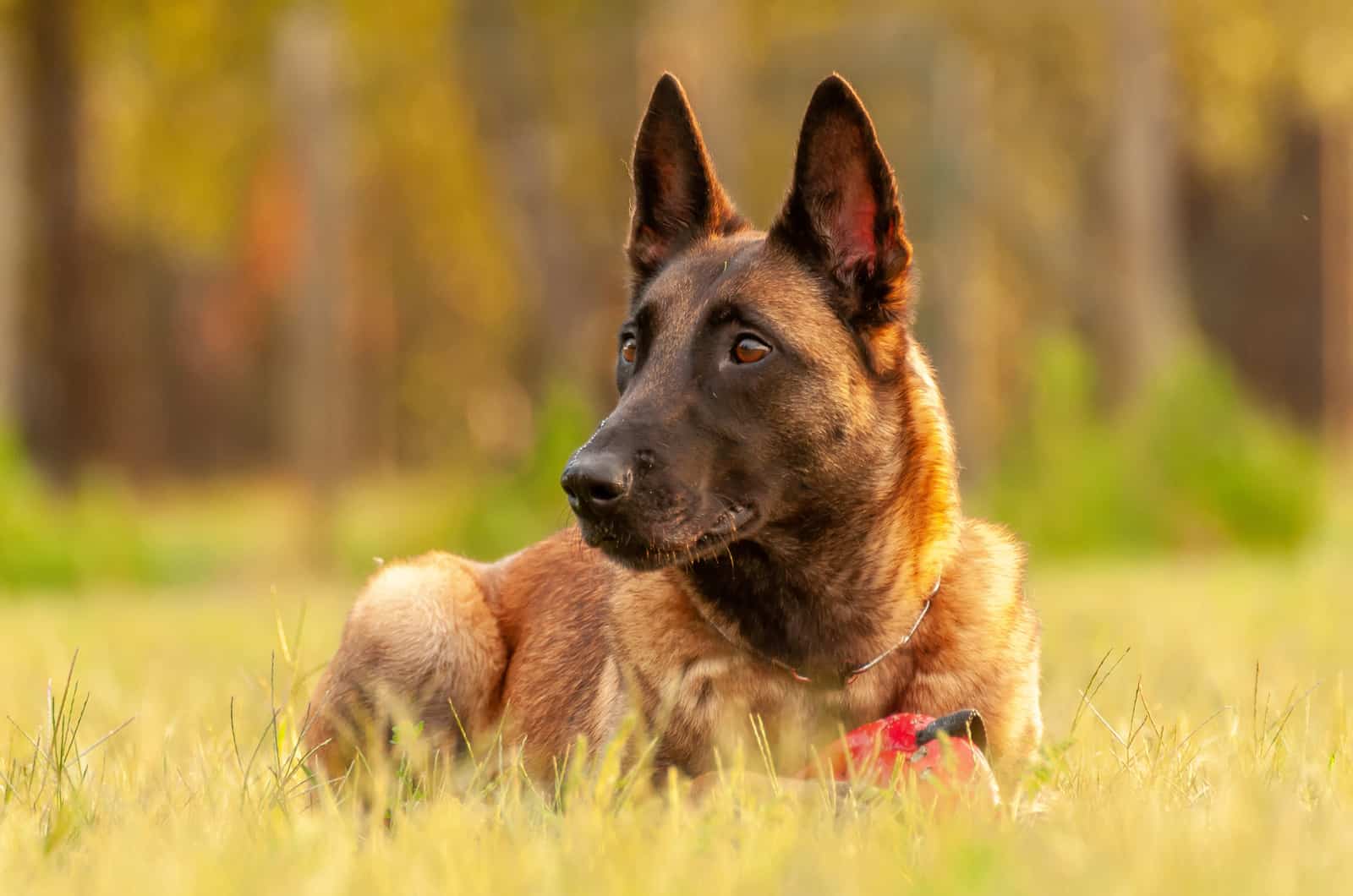
Just like all other dog breeds (and any animal with a coat), Belgian Malinois do shed. They shed moderately throughout the year, but during spring and fall, they might even experience some heavy amounts of shedding.
Shedding is a normal process. Dog hairs grow old and die, and even dogs that are considered non-shedding still change their coat. The only difference is how much of that loose hair ends in the air and on your floor.
Fortunately, the Belgian Malinois is far from the worst dog breed when it comes to shedding. There are many breeds that will make a far worse mess than the Malinois. Still, Belgian Malinois shedding is considerate, and you should be prepared so you can tackle it accordingly.
Belgian Malinois Coat Type
When thinking about Belgian Malinois shedding, the most important thing you need to look at is the dog’s coat type.
Malinois have a double coat. In other words, they have a soft and dense undercoat, as well as a topcoat that consists of harsh, straight hairs.
Their coat is waterproof and weather-resistant, helping them get by no matter the weather outside. This also helps them when they go swimming, although not all Malinois will like water.
One thing not everyone knows is that Belgian Malinois have a fairly unique coat color. All of their hairs have a black tip. This is also known as the sable coat color. Other than that, they have a black mask on their muzzle, and black ears.
They might have some other black markings, but these two are mandatory for a dog to be approved by the American Kennel Club (AKC)’s Standard.
How Much Do Belgian Malinois Shed?
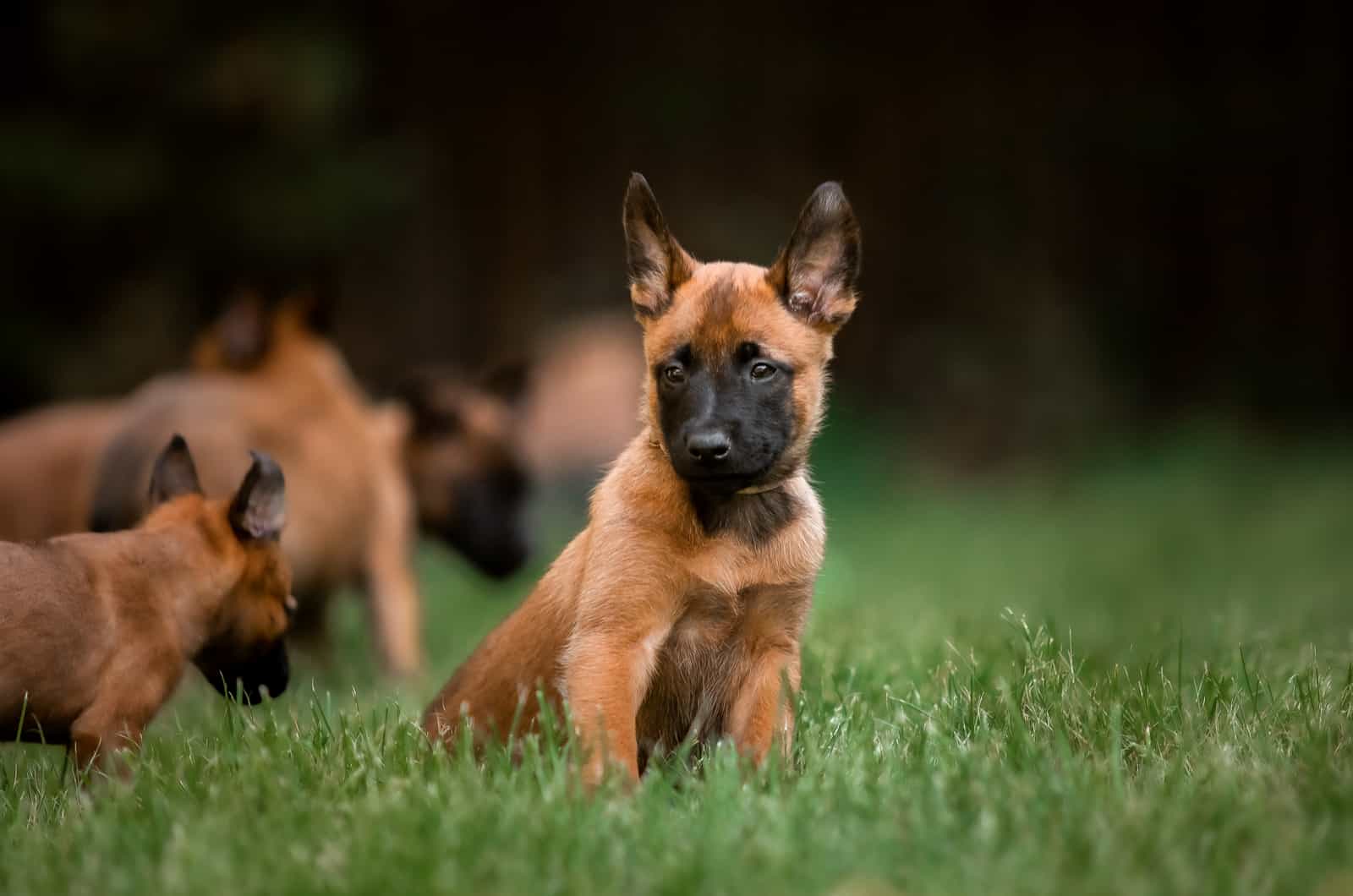
Belgian Malinois experience a moderate amount of shedding. They are far from breeds that shed a lot, such as Collies or Huskies, but you’ll still have to go and clean after them.
The amount of shedding will increase in spring and fall, though. This is the time when you should prepare for some heavy Belgian Malinois shedding.
Of course, seasonal shedding is a normal process that all dog breeds go through. This happens because the weather is changing, and the dog has to prepare his coat for colder or warmer temperatures.
For example, in summer, Belgian Malinois don’t require a thick, heavy coat. This is why they’ll shed their winter coat. This excessive Belgian Malinois shedding that dog owners panic about is to help them cool off in warm weather.
Similar to that, in winter, they require protection from the cold weather. For their coat to become thicker, they must first shed the thin hairs they had on their summer coat.
Is A Belgian Malinois Hypoallergenic?
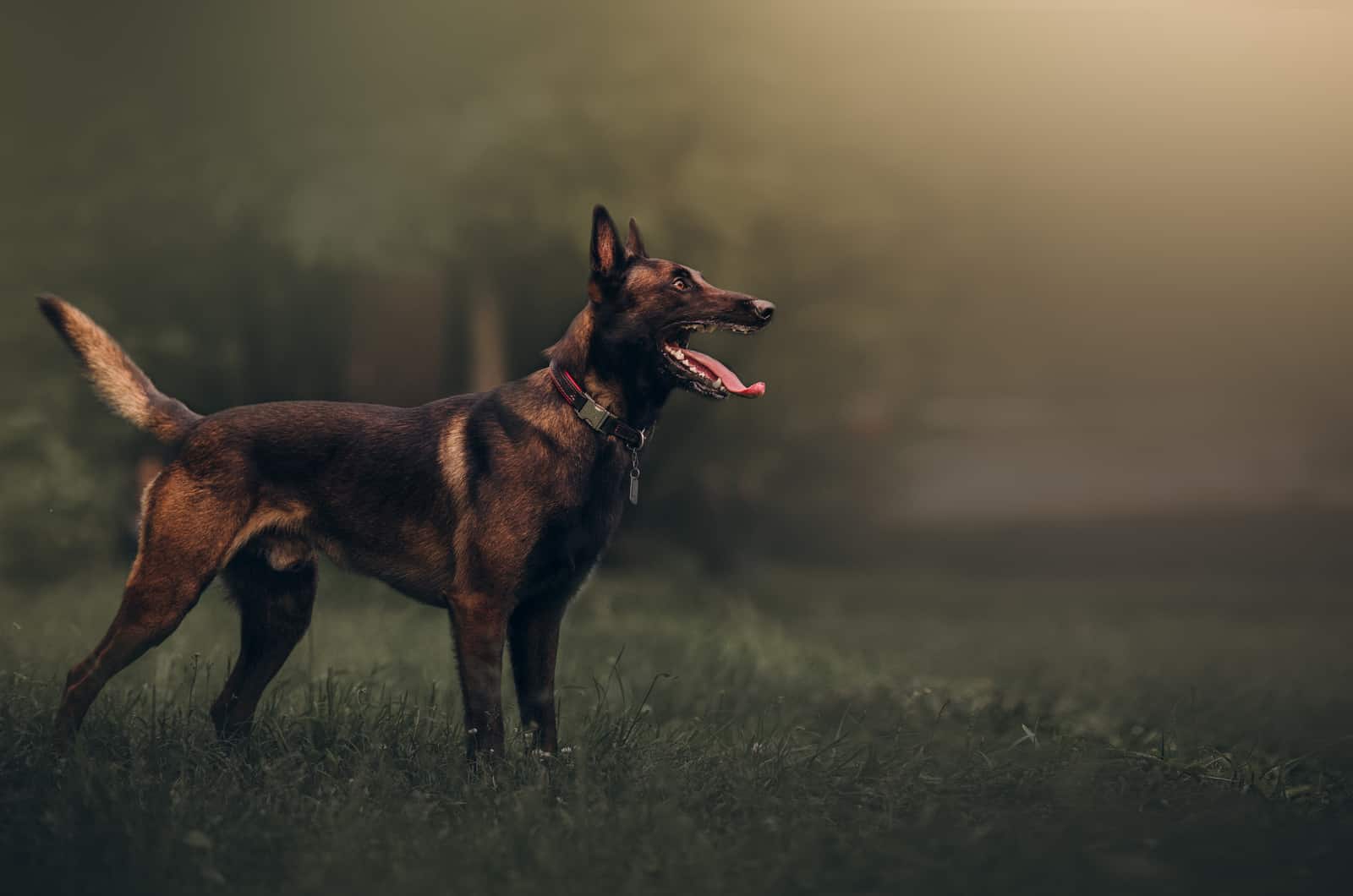
Before we answer this question, we have to define what hypoallergenic means.
This is a term you’ve probably seen plastered everywhere. There are hypoallergenic cosmetics, clothes, and even food. But, what does this mean when it comes to dogs?
Some people have dog allergies. It is a common misconception that they sneeze or get breathing issues when they breathe in dog hairs because they cause these problems.
However, it is, in fact, dander, saliva, and urine that are causing allergies to dogs in humans. Dog hair is simply a vessel on which allergens travel around and into our noses.
As you have probably guessed, all dogs produce dander, urine, and saliva. Therefore, it is impossible for any dog to be entirely hypoallergenic. However, low-shedding dog breeds, such as Poodles, don’t spread their allergens everywhere. This means that you likely won’t have any problem when around them unless you have severe allergies.
Unfortunately, Belgian Malinois cannot be considered hypoallergenic by any means. Belgian Malinois shedding is too high for people who struggle with dog allergies, so this might not be the best dog for you.
This is especially the case during the shedding seasons when the shedding amount is higher than usual.
At the same time, this might be a problem if you have family members and friends with dog allergies. Dead hairs can fly everywhere, spreading allergens and getting stuck onto your furniture and clothes.
How to Prevent Dog Allergies
If you want to get a Belgian Malinois but have issues with dog allergies, don’t despair just yet. There are a few things you can do to prevent the symptoms and reduce irritations.
First things first: Just because you had an allergic reaction to some dog doesn’t mean you’ll have a reaction if you get in contact with a dog of another breed. Many people have issues with just one dog breed, and others won’t cause them any problem.
Also, a dogs’ hair changes as they grow older. Unfortunately, many dog owners have had to find new homes for their pets once they’ve grown up. Adult dogs have different hairs from puppies, and this can lead to some unfortunate events.
Before you get a Belgian Malinois, see if some of your friends or acquaintances have the same dog breed. Ask them to spend some time with the dog and see how your body will react. This might give you an idea of whether you can handle being around Belgian Malinois.
Here are a few lifestyle changes you might consider doing:
•Avoid touching your face or eyes after being in contact with dogs.
•Wash your hands with soap after touching canines.
•Use a heavy-duty vacuum cleaner every day.
•Wash the bedding weekly.
•Don’t sleep in the same bed as your dog.
•Don’t allow your dogs in the bedroom – at all.
•Restrict dogs to specific rooms.
•Whenever possible, brush and clean your dog outdoors.
•Consult with your doctors about antihistamines or other medication.
If none of these work, you might not be able to keep a Belgian Malinois as a pet. However, this shouldn’t prevent you from becoming a dog owner. There are many hypoallergenic dog breeds out there that will rarely cause allergies.
You might even want to check out some Belgian Malinois mixes as they might be more hypoallergenic than purebred dogs.
Can You Reduce Belgian Malinois Shedding?
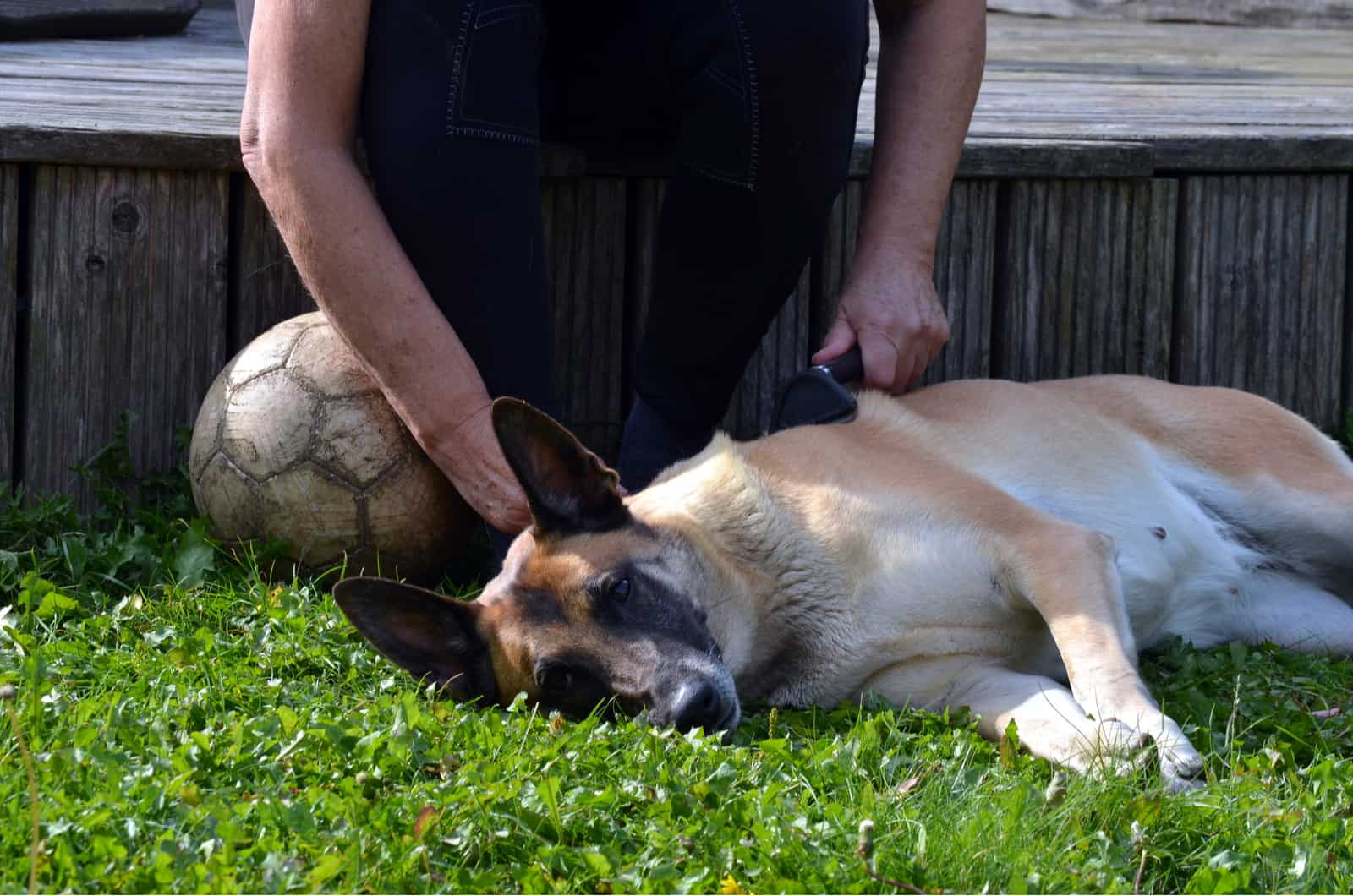
As we’ve already mentioned, Belgian Malinois aren’t the worst shedders out there. However, this shedding amount can still be overwhelming, especially if you don’t know how to take care of a Belgian Malinois’ coat in advance.
Leaving your dog as is throughout the year and not taking care of his coat isn’t a solution. Quite the opposite – the shedding might become too much to handle.
Fortunately, with good grooming and care, you can reduce your Belgian Malinois shedding to a more manageable level. No one wants to have dog hairs flying everywhere, and you can combat this.
Here are a few tips on how you can reduce the shedding amount in your Belgian Malinois dog:
Brushing
Belgian Malinois have short, thick hair. Because of this, they are effortless to groom, and you can take care of them easily. Maintaining them doesn’t take much time, especially when compared to heavy shedders. This is a good thing as high-energy dogs, such as Malinois, might not be patient enough for long grooming sessions.
Still, you should brush your Belgian Malinois at least twice a week. This frequency should increase during the shedding season when the shedding increases. If possible, shed your Belgian Malinois at least every two days.
Brushing is important as it helps remove dead hairs from the dog’s coat. If you pick them up before they fall on the floor, you won’t have to clean them later on. If you do this consistently, it will make your life much easier later on.
As for the best dog brush for a Belgian Malinois, it might be a good idea to buy a pin brush. These tools are amazing for dogs with short hair that have a shedding problem. Shedding blades or deshedders are amazing during the shedding seasons.
Fortunately, there are many different dog brushes that you can buy both in pet stores and online on sites such as Amazon. If you’ve bought your Belgian Malinois puppy from a reputable breeder, they might also help by recommending a brush that they’ve found works the best.
During shedding seasons, it might be a wise decision to brush your pup outside. This means no dog hairs inside the house. If you have a backyard, this is a great thing to do.
If you share a backyard or a porch with a neighbor, make sure to consult with them before going outside for dog brushing. They might not be overly fond of having dog hair flying on their property.
Bathing
Bathing isn’t as important as brushing. While you should bathe your Belgian Malinois from time to time, this can do more harm than good if you go overboard.
If you bathe your pooch more than you should, you are risking him developing some severe skin problems. This will worsen the amount of dander, which will cause issues with dog allergies as well.
Giving your herder a good sponge bath when he gets really dirty or stinky is still a good idea. Just make sure to use a dog shampoo as products made for human skin aren’t appropriate for dogs. They can cause irritation and dry skin.
Using a dog conditioner is one of the ways you can ensure your Malionis’ coat is soft and shiny. A high-quality product will also make his hair healthy, so it might fall out less.
Also, a flea bath is important, especially if you’ve taken your dog outside without any other anti-parasite method. It will kill any pest living on your pet’s coat, and help him get relief.
If you have to bathe your Belgian Malinois, make sure to brush him beforehand. Brushing helps get rid of tangles and mats, which will ensure a healthy coat. For that same reason, you might want to brush him right after bathing as well.
Is Shaving a Good Idea?
Some dog owners like to shave their dogs in order to reduce the amount of shedding. They might even advise you to do the same. While it is true that this will reduce Belgian Malinois shedding, this is entirely wrong, and it can cause severe health problems for your dog.
Unless your vet has advised you to do so out of some medical concerns, you shouldn’t shave your Belgian Malinois, or any other dog breed for that matter.
Canines have hairs for a reason. If you shave a dog, you will disturb his natural insulation process. Dog hairs are important for regulating body temperature, and if you shave them away, you will cause severe problems.
Also, if you shave a dog, you will leave him exposed to parasites and fleas. Without the hairs to protect them, Belgian Malinois can easily be bitten and attacked by insects. These bites can further cause skin infections, which can later lead to hair loss and excessive shedding.
If you shave your Belgian Malinois’ already short coat in summer, your pup might get sunburns. His skin is not used to the sun, especially without hairs that can protect him from the scorching heat.
Not to mention that his hair might not grow back in time for winter, so you’ll leave him exposed to cold, and he can even get frostbite!
So, while shaving seems like a good concept for reducing Belgian Malinois shedding, it isn’t good for your dog and it will harm it.
Hair Loss Vs. Belgian Malinois Shedding
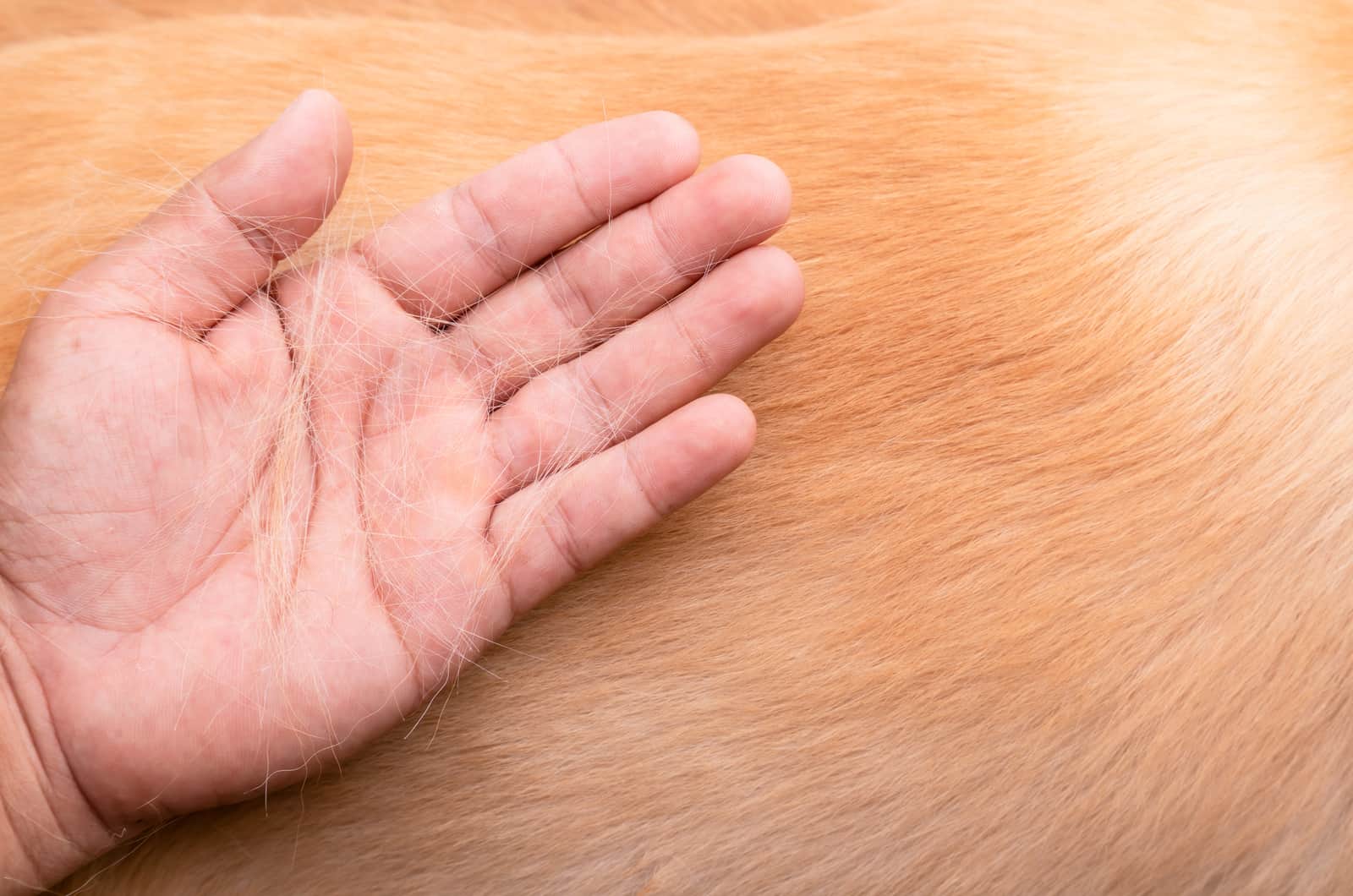
Hair loss isn’t the same as regular Belgian Malinois shedding. It is far worse than even the most excessive seasonal shedding as it can leave your dog’s skin exposed and create bald patches.
Hair loss is common in all dog breeds – except in those that are already hairless. It can be caused by many different reasons, such as:
•Allergies
•Skin infection
•Parasites
•Poor diet
•Severe health issues
Hair loss can affect all Belgian Malinois, no matter their age. The same can be said for any dog breed out there. This condition doesn’t differentiate between the breed, size, or age of your dog.
Fortunately, hair loss can be prevented. However, before you can do this, you need to understand what caused it. Because of this, you should always take your dog to the local vet if you notice signs of hair loss. This can also help rule out some severe health conditions.
Here are a few things you need to know about hair loss in Belgian Malinois:
Symptoms of Hair Loss
If you know the symptoms of hair loss, you might better understand the difference between it and regular Belgian Malinois shedding.
Overall, hair loss can manifest itself in:
•Hair thinning
•Hair loss around the dog’s nose and eyes
•Bald patches
•Itchiness
•Dry skin
•Inflammation of the skin, or even bleeding
Hair Loss Causes
There are several possible causes of hair loss in dogs. Some things are easy to notice and deal with; others, not so much.
For example, dog collars can cause friction, and this can lead to hair loss on the dog’s neck. Fortunately, this one is easy to guess as bald patches will stay close to the collar.
Stress is another huge cause of hair loss. If your dog has been through a traumatic event or if there was a change in his environment, he might lose some hair.
Many health conditions can also lead to hair loss. For example, fungal or bacterial infections can cause bald patches, and they can happen to any breed. Female dogs might lose some hair after giving birth as their hormones will be disrupted.
Unfortunately, Belgian Malinois are prone to thyroid disorders and alopecia. If you notice that your Belgian Malinois shedding has become so high that he starts developing bald patches, he might have some of these conditions.
Some forms of cancer might lead to overall health deterioration, which can result in hair loss as well. Because of this, you should always take your dog to the vet if you notice a sudden, unexplainable change in his shedding amount.
Can You Prevent Hair Loss?
Luckily, for both you and your dog, most of these causes of hair loss can be prevented with a few helpful tips.
First and foremost, you need to take good care of your dog and ensure that he is happy. Good mental health can keep most disorders at bay, and hair loss is among them.
Regular grooming is the second most important thing. While Malinois don’t require visits to a professional vet, make sure to brush them according to the schedule we’ve mentioned.
Giving your Belgian Malinois proper dog food is also a good thing for keeping shedding at bay. Certain nutrients, such as fish oils and healthy fatty acids (omega 3 and omega 6, most notably), are great for your dog’s skin and coat.
Good nutrition can not just help with Belgian Malinois shedding, but it can improve his overall health. If your dog is kept at an optimal weight, he’ll have slim chances of developing most orthopedic issues, such as hip and elbow dysplasia.
Dog breeds with high energy levels, which includes the Belgian Malinois, should also have regular exercise. This will keep them healthy, and as a result, their coat will thrive.
Don’t use any harsh chemical near your dog, and don’t use products made for humans on their skin. These will likely irritate your pooch and cause harm.
Finally, if you notice any sign of hair loss, don’t attempt to use any home remedy, and don’t ignore the problem. Take your doggie to the veterinarian as soon as possible. They can help you with your future steps.
Dealing with Dog Hairs in the House
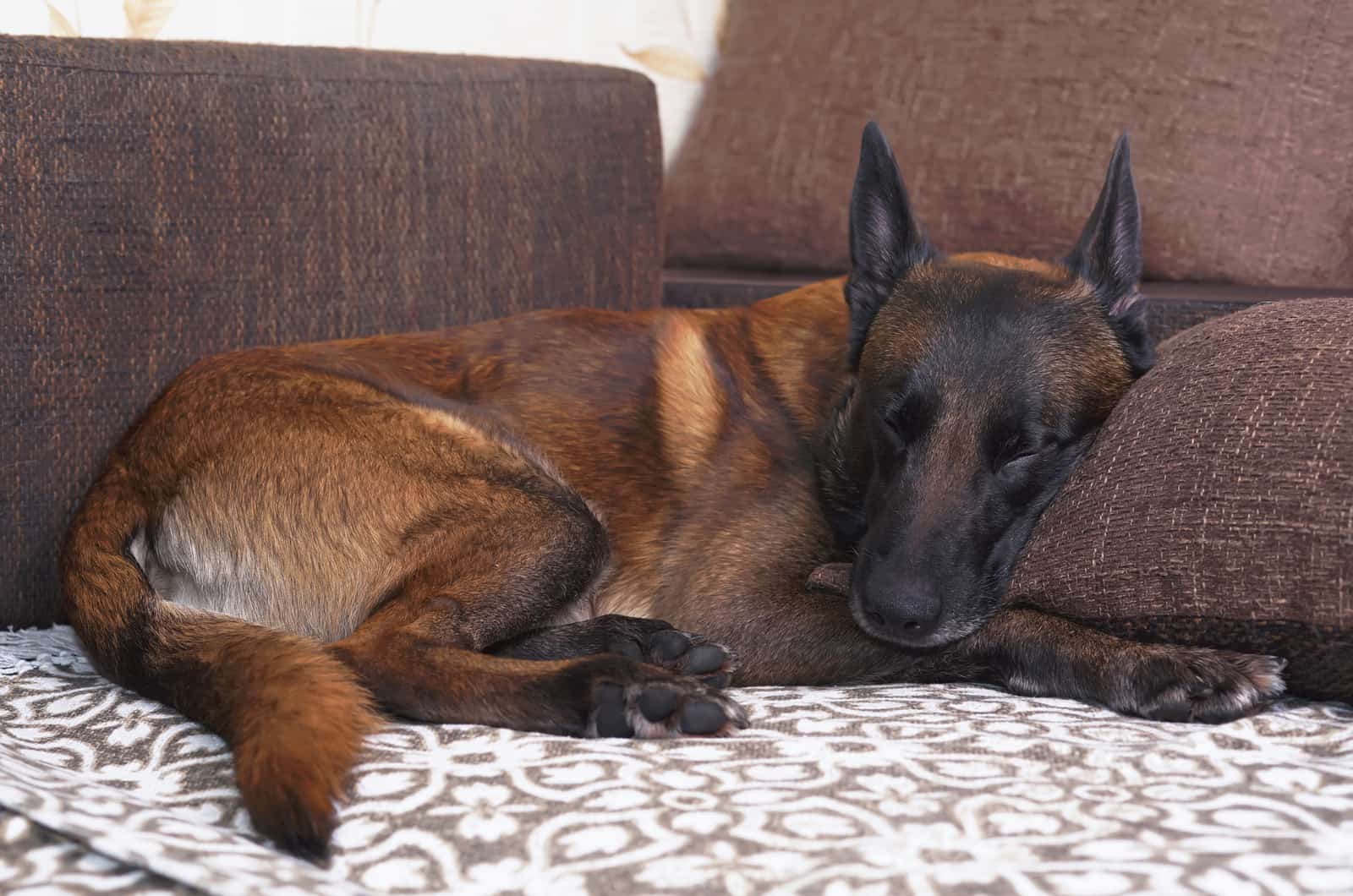
Most dog lovers would agree that dealing with dog hairs is just another part of dog ownership. It is a small price for getting a best friend that will stay with you for the rest of his days.
However, this isn’t to say that you should underestimate the value of hair cleaning tools. There are some items that dog owners simply cannot live without – and we are not talking about poop bags or food bowls!
Here are some items all Belgian Malinois owners should keep nearby:
•Grooming mitts:
They can be used both as a grooming tool and to help you during cleaning. You put them on, then pet your Belgian Malinois. All loose hairs will stay on the gloves instead of flying around. The same goes for cleaning hairs from the furniture. A good grooming mitt will not allow any hair to escape it.
•Lint rollers:
This is the perfect tool for cleaning clothes and furniture. It is available everywhere. Even many clothing stores have started selling them! However, they are suitable for smaller cleaning jobs. If you plan on cleaning your entire sofa, you might prefer vacuuming it.
•Vacuum cleaner:
A good vacuum cleaner is an important part of every house. However, if you are a dog owner, you’ll know how to appreciate buying a good product. A vacuum cleaner can be your best friend if you’re dealing with a dog that sheds a lot, such as the Belgian Malinois.
•Furniture covers:
If you really hate having dog hairs everywhere, your best option would be to invest in furniture covers. You can keep them on your furniture, then remove them and place them in the washing machine before the guests arrive.
Belgian Malinois Vs. German Shepherd Shedding
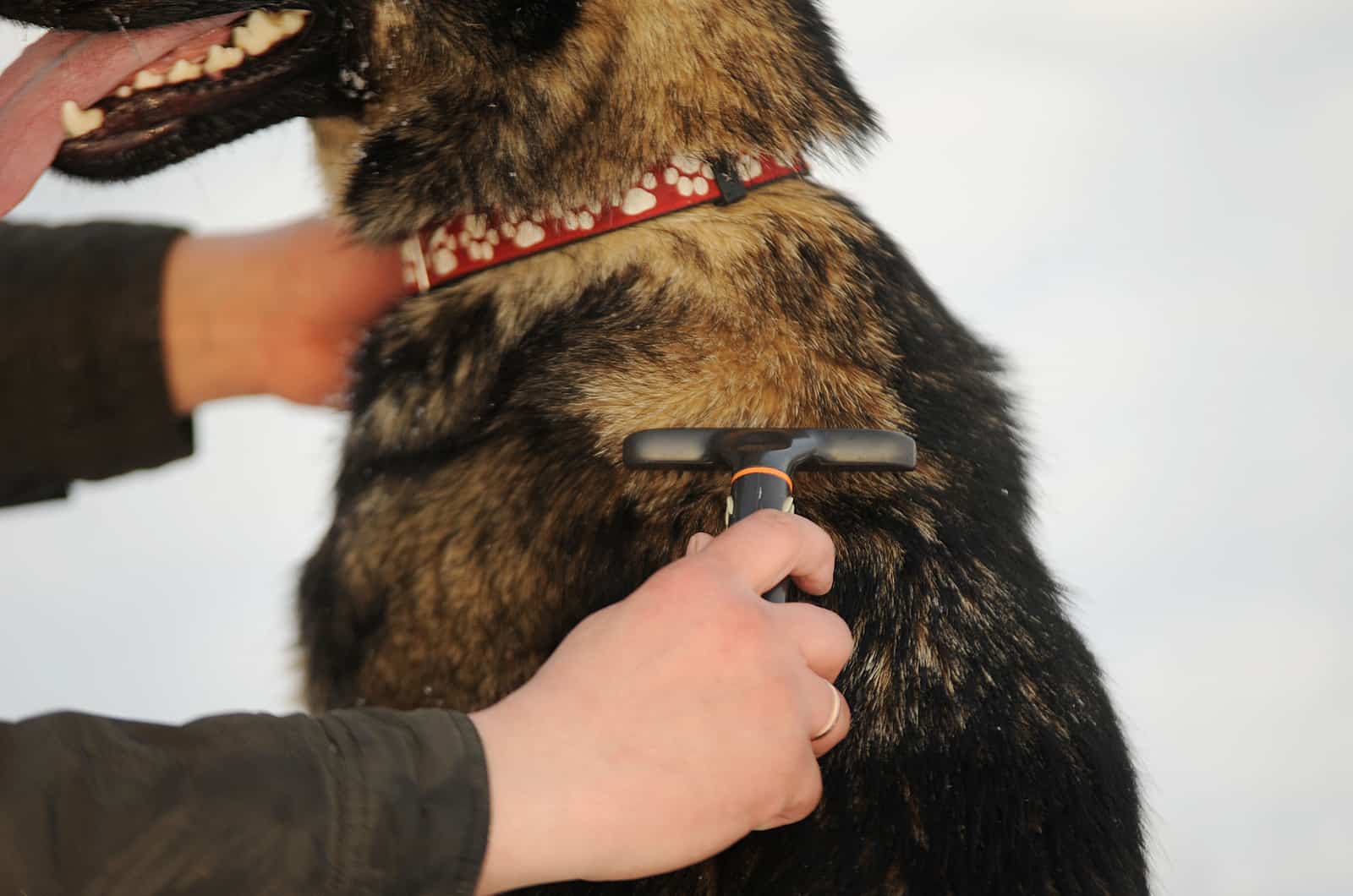
We’ve already mentioned that Belgian Malinois and German Shepherds are rather similar. However, when it comes to German Shepherd vs. Belgian Malinois shedding, there are a few things worth noting.
First off, both of these dog breeds shed. However, German Shepherds, which are known to come in short-hair and long-hair varieties, shed significantly more compared to Malinois. They will require much more maintenance – especially if we’re talking about long-haired German Shepherds.
While both have double coats, a German Shepherd’s hair is longer and coarser compared to a Belgian Malinois. This is one of the reasons why they require much more grooming.
Another reason is that German Shepherds are the larger of the two. Larger dogs mean more hair that can fall off, which will result in heavier cleaning.
Should You Get a Belgian Malinois?
Belgian Malinois are mostly known for being amazing working dogs. They excel at search and rescue activities, and they can guard your house with excellence. They are usually kept as guard dogs, but many people love having them as family pets.
However, just like with all dog breeds, some hair loss is to be expected. Dealing with Belgian Malinois shedding is a small price for getting such a loyal companion that would die for you – although such a dramatic scene isn’t likely.
Also, these pups don’t shed nearly as much as most long-haired breeds, so if you’re used to cleaning dog hair, owning a Malinois might even feel like a vacation! The only time when the shedding might get out of control is during the two shedding seasons.
Unfortunately, if you’re an allergy sufferer, a Belgian Malinois might not be the best dog for you. Their shedding amount can cause problems, and if your allergies are severe, it’s best not to risk it.
Other than that, these intelligent and brave dogs can make amazing family companions – as long as you show them who is the alpha dog of the pack.
